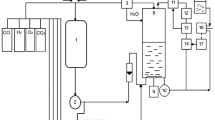Abstract
Copolyesters of 3-hydroxybutyrate (3HB) and 3-hydroxyvalerate (3HV) were produced at 30°C from various carbon sources byAlcaligenes eutrophus under batch-fed growth conditions. The production of P(3HB-co-3HV) from butyric and pentanoic acids was effective under nitrogenlimited conditions, and the conversion of carbon sources into copolyester was as high as 56 wt% at a C/N molar ratio of 40. In contrast, under excess-nitrogen conditions (C/N<10), cell growth was good, while P(3HB-co-3HV) production was partially inhibited. The production of P(3HB-co-3HV) from fructose and propionic acid was almost completely inhibited under excess-nitrogen conditions.
Similar content being viewed by others
References
A. J. Anderson and E. A. Dawes,Microbiol. Rev. 54 450–472 (1990).
Y. Doi,Microbial Polyesters (VCH, New York, 1990).
D. Byrom,Trends. Biotechnol. 5 246–250 (1987).
U. J. Hanggi, inNovel Biodegradable Microbial Polymers, E. A. Dawes, ed. (Kluwer Academic, Dordrecht, Boston, London, 1990), pp. 65–70.
M. Lemoigue,Ann. Inst. Pasteur. 39 144–173 (1925).
E. A. Dawes and P. J. Senior,Adv. Microb. Physiol. 10 135–266 (1973).
V. Oeding and H. G. Schlegel,Biochem. J. 134 239–240 (1973).
P. J. Senior and E. A. Dawes,Biochem. J. 134 225–238 (1973).
S. Bloembergen, D. A. Holden, G. K. Hamer, T. L. Bluhm, and R. H. Marchessault,Macromolecules 19 2865–2871 (1986).
P. A. Holmes,Phys. Technol. 16 32–37 (1985).
Y. Doi, M. Kunioka, Y. Nakamura, and K. Soga,J. Chem. Soc. Chem. Commun. 1696–1697 (1986).
Y. Doi, M. Kunioka, Y. Nakamura, and K. Soga,Macromolecules 20 2988–2991 (1987).
Y. Doi, A. Tamaki, M. Kunioka, and K. Soga,Appl. Microbiol. Biotechnol. 28 330–334 (1988).
B. Sonnleitner, E. Heinzle, G. Braunegg, and R. M. Lafferty,Eur. J. Appl. Microbiol. Biotechnol. 7 1–10 (1979).
Y. Doi, A. Segawa, Y. Kawaguchi, and M. Kunioka,FEMS Microbiol. Lett. 67 165–170 (1990).
G. W. Haywood, A. J. Anderson, L. Chu, and E. A. Dawes,FEMS Microbiol. Lett. 52 91–96 (1988).
G. W. Haywood, A. J. Anderson, L. Chu, and E. A. Dawes,FEMS Microbiol. Lett. 52 259–264 (1988).
G. W. Haywood, A. J. Anderson, L. Chu, and E. A. Dawes,FEMS Microbiol. Lett. 57 1–6 (1988).
P. Schubert, A. Steinbuchel, and H. G. Schlegel,J. Bacteriol. 170 5837–5847 (1988).
Author information
Authors and Affiliations
Rights and permissions
About this article
Cite this article
Koyama, N., Doi, Y. Production of poly(3-hydroxybutyrate-co-3-hydroxyvalerate) from various carbon sources by batch-fed cultures ofAlcaligenes eutrophus . J Environ Polym Degr 1, 235–240 (1993). https://doi.org/10.1007/BF01458032
Issue Date:
DOI: https://doi.org/10.1007/BF01458032




